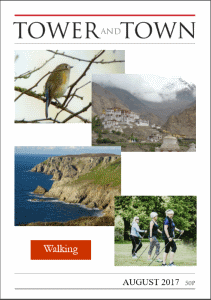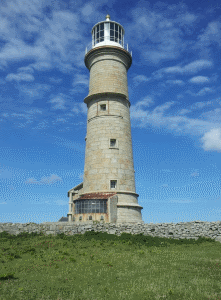

Tower and Town, August 2017 (view the full edition) (view the full edition)Walking On LundyLundy, Fastnet, Irish Sea. Sound familiar? Lundy is not just a British sea area. At the point where the Atlantic meets the Bristol Channel, 12 miles off the coast of North Devon, proudly stands magical, unspoilt Lundy. With nothing between it and America, West Side is stunningly rugged and craggy with rock-stacks, caves and inlets. By contrast, East Side has gentle, grassy sidelands. Lundy (old Norse for Puffin Island) is an enchanting granite outcrop, 3 miles long and ½ mile wide, rising 400 feet above sea level. You would be mistaken if you thought it would not take long to walk and discover the island! Without signposts or any real designated routes, the walker is free to roam at will. Every season holds fascination for the amateur or avid ornithologist, naturalist, historian, geologist, archaeologist or anyone wanting to enjoy peace and tranquillity away from the hurly-burly of modern day living. The Village, comprising a tavern, shop, unique cottages (Landmark Trust), church, and working farm, is located towards the south of the island. It is from here your walking experiences begin. A cliff top ramble will reveal many island secrets. On a clear day it is possible to experience an all-round channel panorama from St. Anne’s Head, Pembrokeshire to Trevose Head, Cornwall. However, on days of haze or mist you get a wonderful feeling of total isolation. Walking anticlockwise, north along East Side, you will pass the ruins of Belle Vue Cottages and Old Hospital, built by the short-lived Lundy Granite Company in the 1860s; evidence of quarrying is still visible. Continuing on past notable outcrops, the old Admiralty lookout at Tibbetts Point is the most remote Landmark property on Lundy. With several opportunities to reach sea level, the steep, grassy descent to Brazen Ward is one not to be missed – a perfect place to observe seals at close quarters. Further on, at Gannets’ Bay, you will hear seals’ calls and see them swimming in the clear, turquoise sea or hauled out on rocks. Approaching North End, Bronze Age archaeological features can still be seen amongst the ‘wave-formed’ heath that dominates this end of Lundy. The more daring walker may find a route to sea level, via North Light, where inquisitive seals soon appear before plunging playfully back into the waves. Leaving North End, heading south, the cliffs, sculpted by the powerful and relentless Atlantic waves, are visually spectacular. A prime position at Squire’s View offers an excellent vista of the dramatic coastline. Devil’s Slide, the largest single slab of granite in Europe, slips into the sea - a challenge for many intrepid climbers. Named after a shipwreck in 1797, Jenny’s Cove, a large sweeping bay, provides ideal viewing of puffins, razorbills, guillemots and a variety of gulls during nesting season. Passing deep fissures known as The Earthquake you discover the granite-walled pathway down to The Battery with derelict cottages and cannon - fired to warn ships in fog during the 1800s. Heading towards Lundy’s highest point, Old Light rises 567 feet above sea level. The lighthouse proved too high to be useable in fog and operation ceased in 1897. Ascending its 147 steps affords the most spectacular 360º panoramic view. Admire and explore the significant St. Helen’s Church (currently undergoing restoration), with 10 ringable bells, before heading further south to The Castle, a smuggler’s cave and Landing Bay. Lundy is an important stop-over for migrating birds, often with national rarities being recorded. Sea birds colonise Lundy’s cliffs with the ground nesting Puffin and Manx Shearwater numbers increasing after rat eradication. The island boasts the endemic Lundy Cabbage with its endemic insect pollinators and its own breed of pony. Volunteering with Lundy Field Society helps conserve its wildlife and antiquities. Several Marlborough people regularly visit to carry out conservation work. The last private joint owner of Lundy (before ownership passed to National Trust in 1969), Diana Keast, lives in Marlborough. Many of her local friends have been enriched by a ‘Lundy experience’. Diana maintains many links with Lundy and is President of the Lundy Field Society. Walk on Lundy and fall under its magical spell. Lundy: Wind; yes. Sea state; wet. Weather; plenty. Visibility; very good!   Tevor and Karen Dobie |